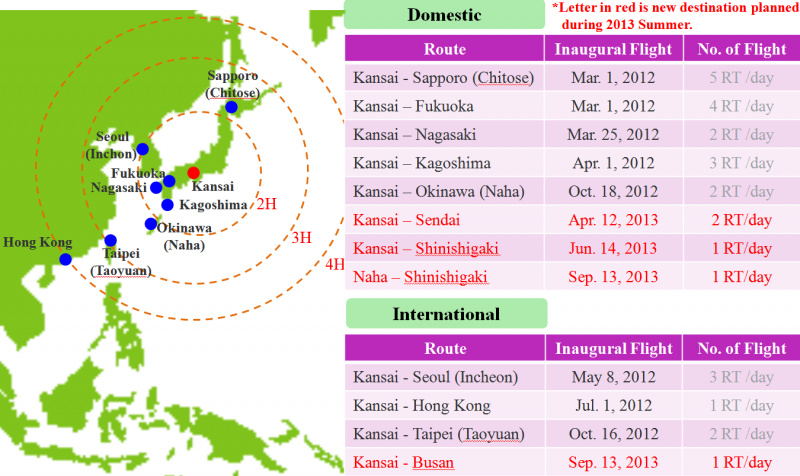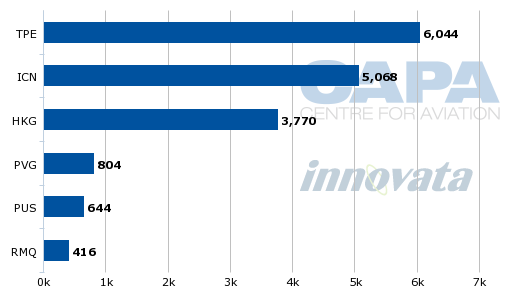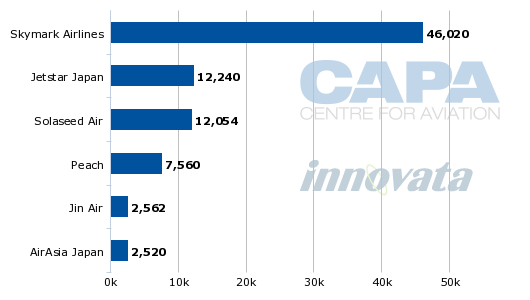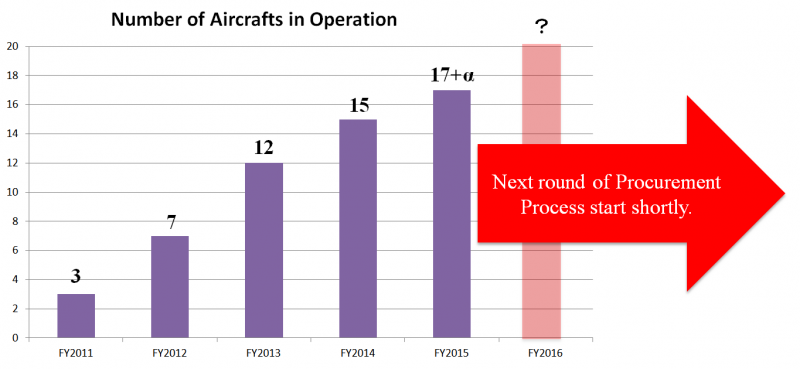Low-cost airline Peach boldly pursues Japan-Southeast Asia one-stop market using new Okinawa base
Japan's Peach Aviation is looking at several potential markets in Southeast Asia as part of a new base in the southern Japanese island of Okinawa. The low-cost carrier is bullish on the Okinawa market, which it already serves from its Osaka Kansai base.
Peach is planning domestic expansion at Naha on Okinawa, starting with service to Shin Ishigaki in Sep-2013. It aims to start international operations at Naha as soon as the airport's low-cost terminal, which opened specifically for Peach in Oct-2012, is upgraded to handle international flights.
Peach expects the Okinawa base will attract a high volume of transit passengers heading from its various destinations in Japan to Southeast Asia. But at least for now Peach plans to rely on self-connections rather than offer a connecting product. Peach already sees a large number of self-connections coming from its international destinations, particularly Hong Kong.
Peach currently operates five domestic and three international routes from its Kansai base with a fleet of seven 180-seat A320s. The carrier has already unveiled plans to add three domestic and one international route in the first half of the fiscal year beginning 01-Apr-2013 (1HFY2013). This includes Okinawa-Shin Ishigaki, which will be Peach's first route that does not originate at Kansai.
Peach current and upcoming network
The upcoming expansion is made possible as Peach is slated to take its eighth A320 in early Apr-2013 and have a fleet of 10 aircraft by summer 2013. More expansion, including at Okinawa, is expected in 2HFY2013 as Peach expands its fleet to 12 aircraft.
See related articles:
- Peach holds strong, AirAsia Japan drops CEO and Jetstar Japan reduces Kansai; Nagoya new battleground
- As new Japanese LCCs settle in - AirAsia, Jetstar and Peach - strategy differences become apparent
Peach considers Bangkok, Ho Chi Minh and Hanoi
Peach CEO Shinich Inoue told the CAPA Aviation Finance Asia Summit in Singapore on 20-Mar-2013 that the carrier's new Naha base will open up network opportunities in Southeast Asia. Unlike other parts of Japan, Okinawa is within four hours flying time of portions of Southeast Asia. Peach wants to operate flights of no more than four hours, which is a typical preference for carriers following a pure LCC model. Peach's longest route is now Osaka-Hong Kong, which is about four hours.
Peach executives told CAPA that destinations in Southeast Asia that are now under evaluation include Ho Chi Minh and Hanoi in Vietnam as well as Bangkok in Thailand. Singapore and Kuala Lumpur are not under consideration as it is outside the four hour radius from Okinawa.
Singapore, Kuala Lumpur and the Indonesian island of Bali are over 2,000nm from Naha, making it about a five-hour flight. Bangkok is about 1,700nm, Ho Chi Minh is about 1,500nm and Hanoi is only 1,200nm, which is about the same distance as Okinawa to the north island of Japan. Peach's longest current route, Hong Kong-Kansai, is about 1,400nm.
Peach executives tell CAPA that the carrier is also looking at linking its new Naha base with the North Asia international destinations of Hong Kong, Busan, Seoul and Taipei. These are also the carrier's first four international destinations, with Hong Kong, Seoul and Taipei already served and Kansai-Busan service slated to start on 13-Sep-2013. By linking Naha with these destinations Peach can leverage its existing network, thereby reducing start-up costs and risk.
Peach previously flagged the concept of serving China from Okinawa. But Japan-China services are currently not being considered due to the political tensions between the two countries, which has significantly reduced demand for services between Japan and China.
See related article: China-Japan traffic bottoms out, but faces massive challenge
The Okinawa-North Asia and Okinawa-Southeast Asia markets are very different in that only the former attracts inbound tourists. There is limited to no demand for Southeast Asia as a source market for Okinawa's tourism industry. As a result Peach plans to target outbound Japanese heading to Southeast Asia while potential Northeast Asia routes will rely more on inbound tourists. As Okinawa has a very small local market - the island's population is only about 1.3 million - Peach will need to rely heavily on connecting passengers from Japan's more populated islands to the north to make its planned Okinawa-Southeast Asia services viable.
Peach not convinced about benefits of offering connection product
Peach is interested in exploiting Okinawa's strategic geographic position and using Naha as a hub for traffic from Japan's population centres to Southeast Asia. But Mr Inoue says for now Peach has no plans to offer a transfer product and will continue to rely on self-connections.
Peach should relook at its connection strategy and join other LCCs in offering a connection product. In recent years several LCCs, including LCCs in Asia, have added connection products in which the cost is covered by selling the convenience of a through check-in for a fee. Passengers still have the option of self-connecting should they not want to pay the fee.
Peach would first need to upgrade its reservation system to support such a product. The carrier's simple current reservation system is unable to support sum of sectors, which is the method most LCCs use in pricing out and selling itineraries that involve connections. Peach for now is not looking at moving to Navitaire or other LCC IT platforms that can support connections and other hybrid components of the LCC model such as interlining and codeshares.
So far Peach is unconvinced it is worthwhile to offer a connecting product as it believes its passengers are willing to self-connect, allowing the carrier to keep its simple point-to-point LCC model without adding complexity or investing in IT upgrades. Peach has particularly seen a large number of self-connections to its Kansai-Hong Kong flight. Peach told CAPA about half of the carrier's passengers flying Hong Kong-Kansai connect to Sapporo (Chitose) in northern Japan, where Hong Kong residents like to go skiing.
Peach seeks upgrades to Naha LCCT to support international flights
Self-connections will be particularly easy at Okinawa as Peach uses a simple one-storey low-cost terminal (LCCT) at Naha Airport that was previously a cargo terminal for part-owner All Nippon Airways (ANA). Mr Inoue says Peach is now talking to Okinawa government and airport officials about opening a customs and immigration facility at the Naha LCCT.
Peach is confident that the LCCT can be upgraded to accommodate international flights. The Okinawa government, which is keen to boost international links, is also receptive.
About 96% of seat capacity at Okinawa Naha Airport is now domestic, according to Innovata data. Naha is currently the fourth largest domestic airport in Japan based on current seat capacity but is only the seventh largest international airport in the country with less than 17,000 weekly international seats.
Naha is now linked with just six international destinations, all of which are in North Asia - Taipei, Seoul, Hong Kong, Shanghai, Busan and the secondary Taiwanese city of Taichung.
Okinawa Naha international routes ranked by capacity (seats): 25-Mar-2013 to 31-Mar-2013
If its Naha international routes are launched as expected, Peach will bring new competition and stimulate demand in the Busan, Hong Kong, Seoul and Taipei markets. Among these routes only Naha-Seoul is currently served by an LCC. But other Japanese LCCs - such AirAsia Japan or Jetstar Japan - could look to join Peach in serving these markets. Jetstar Hong Kong, which is planning to launch operations in mid-2013, could also potentially serve Naha.
Hong Kong is currently served from Naha by Cathay subsidiary Dragonair and Hong Kong Airlines/Hong Kong Express. Dragonair currently has four weekly flights while Hong Kong Airlines/Hong Kong Express has a daily service to Naha, according to Innovata data.
Seoul is served with a daily flight from Asiana and a daily flight from Korean Air budget subsidiary Jin Air. Busan is served with only two weekly flights from Asiana.
Taipei is served with 11 weekly flights from China Airlines (CAL) and a daily flight from TransAsia. Taichung is served with two weekly flights from CAL subsidiary Mandarin Airlines. Shanghai is served with two daily flights from China Eastern.
The lack of Japanese carrier international passenger service from Naha reflects the inbound nature of the Okinawa-North Asia market and the fact that Japan's main carriers are focused on offering international services from their main hubs. Peach could struggle to compete against foreign carriers in the Okinawa-North Asia international market given Peach, unlike rival LCCs AirAsia Japan and Jetstar Japan, has a brand that is not well recognised outside Japan.
With its new Okinawa-Southeast Asia services Peach will compete against Japan's main carriers which serve Southeast Asia from its hubs, predominately Tokyo, using widebody aircraft. Southeast Asian carriers also serve Tokyo along with other major Japanese cities.
Peach plans domestic expansion at Okinawa
Peach believes its significantly lower fares will woo Japanese price-conscious passengers who are now flying non-stop to Southeast Asia or on one-stop full-service products via Tokyo and other major Japanese cities. While Peach now only operates domestic flights from Naha to Osaka, it plans to add several more domestic routes to connect with its planned Naha-Southeast Asia flights. Peach does not expect passengers to be willing to connect twice - at Kansai and again at Naha - to reach their final destination.
Naha-Shin Ishigaki will be the carrier's second domestic route at Okinawa. But this is a niche route connecting two popular vacation destinations rather than linking Naha with a major population centre.
Mr Inoue explains that many Japanese tourists look to combine Okinawa and Ishigaki islands, which is considered more natural. But fares between the two islands are high despite the short one-hour flight. ANA and Japan Airlines currently link Naha with Shin Ishigaki with eight daily flights each, according to Innovata data.
Peach will initially offer one daily flight on the Naha-Shin Ishigaki route and three months earlier, in Jun-2013, will launch one daily flight from Kansai to Shin Ishigaki. The latter is another high fare route served by ANA and JAL with two daily flights from each carrier, according to Innovata.
Peach has not yet cited other potential domestic destinations from Naha. The top 10 domestic routes from Naha are Tokyo Haneda, Fukuoka, Osaka Kansai, Shin Ishigaki, Miyaki, Nagoya, Tokyo Narita, Kobe, Osaka Itami and Kogoshima. All these routes are currently served with several daily flights and are potential candidates for service from Peach, with the exception of Haneda and Itami which are slot-controlled airports that Peach is unlikely to serve.
Peach currently operates three daily flights between Naha and Osaka Kansai, which give it a 12% share of capacity in the Naha-Osaka market (includes both Osaka airports), according to Innovata data. Peach's 7,560 weekly seats on the Naha-Osaka route make it the seventh largest carrier at Naha with a less than 2% share of total capacity.
But Peach will see its share of the market drop slightly in May-2013 as it reduces its Kansai-Osaka schedule to two daily flights. Peach will return to three daily flights on the route in mid Jun-2013 and operate a fourth daily flight from mid Jul-2013, according to Innovata data.
Skymark is currently the largest LCC serving Naha, with 46,000 weekly seats and more than a 10% share of total capacity. Other LCCs serving Naha include Jetstar Japan, Solaseed, AirAsia Japan and South Korea's Jin Air. Jetstar Japan serves Naha from its Tokyo Narita and Osaka Kansai bases while AirAsia Japan currently only serves Naha from Narita. Combined LCCs currently account for almost 20% of seat capacity at Okinawa, a figure which will certainly expand after Peach opens a base on the island.
Okinawa Naha LCC capacity (seats) by carrier: 24-Mar-2013- to 31-Mar-2013
Peach has not yet indicated when it will open a base at Okinawa. Mr Inoue first indicated that Naha would be Peach's second base after Kansai when the carrier inaugurated flights to Okinawa on 18-Oct-2012.
Peach plans summer 2013 expansion
Kansai-Okinawa was Peach's eighth and most recent route launch. The carrier has since been taking a six-month hiatus from expanding but will begin a new phase of expansion in Apr-2013 as it uses its eighth aircraft to launch two daily flights from Kansai to Sendai, a route currently only served by ANA. Two more A320s will be added by the end of the summer season and used to launch Kansai-Shin Ishigaki, Naha-Shin Ishigaki and Kansai-Busan. The latter route is currently only served by Asiana.
There will be opportunities for Peach to further expand its network in 2HFY2013, which starts 01-Oct-2013, as two more A320s are added for a total of 12. Expansion at both Kansai and Naha are likely during this period.
Peach is already committed to adding three more A320s for FY2014, which starts on 01-Apr-2014, for a total of 15 by 31-Mar-2015. So far it has also committed to leasing two A320s for FY2015 and plans to secure additional aircraft for 2HFY2015 and beyond over the next few months. Mr Inoue says Peach is now considering additional leased aircraft as well as purchased aircraft for 2HFY2015 and beyond.
Peach fleet plan: FY2011 to FY2015
Peach boldly pursues unique strategy
Peach, which launched services at the end of FY2011 on 01-Mar-2012, has so far transported over 1.5 million passengers. Mr Inoue says the carrier has so far performed better than expectations, with an average load factor of 76% through its first 10 months of operations.
Peach's management team is encouraged by its success at stimulating demand and attracting a passenger profile which is very different to Japanese legacy carriers. For example half of its passengers to date have been female, compared to only 30% for legacy carriers.
The carrier also has attracted a large number of day-trip leisure passengers. For example Peach says its Kansai-Seoul flight is often full with housewives going to South Korea to shop for the day. To cater to its passenger profile, Peach plans to only open routes that can support two daily flights.
Peach has also tried to differentiate from other carriers by pursuing a model that while following all the basic components of LCC has some innovative twists. "We don't want to be a copycat of other LCC models," Mr Inoue stated.
With its Okinawa base Peach will again look to carve out a unique niche, opening up previously un-served routes to Southeast Asia. The new routes will rely heavily on transit passengers, a rather unusual strategy for an LCC, particularly an LCC that does not offer a connection product and relies entirely on self-connections.
Peach may eventually be persuaded to hybridise and upgrade its IT platform to support connections and interlines or codeshares. For now the carrier is content on continuing with its current pure LCC model as it expands ambitiously and adopts bold new network strategies in a typically conservative Japanese market.



